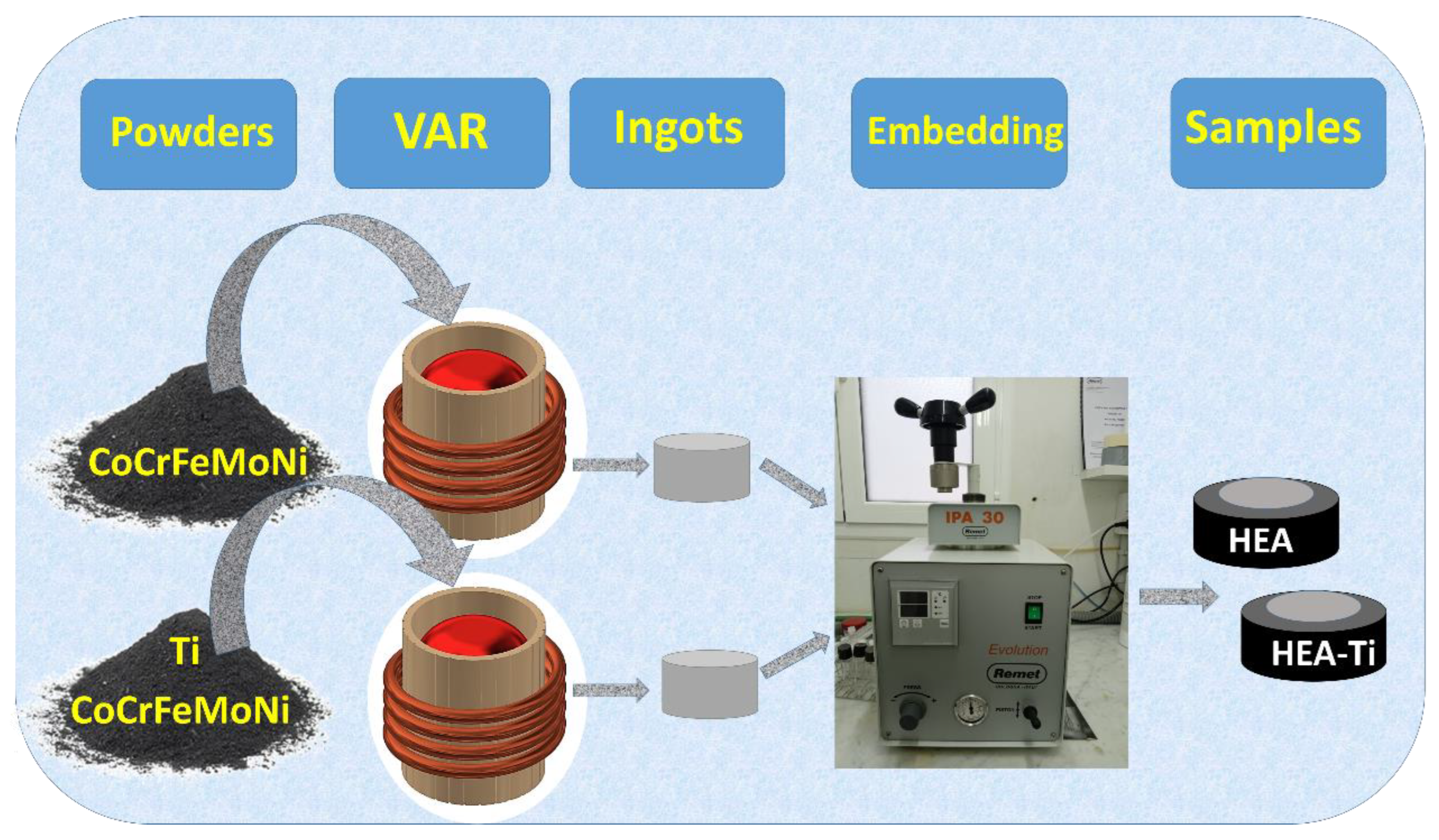3.1. Microstructural Characterization
To study the effect of Ti doping on the microstructure, the base CoCrFeMoNi alloy (
Figure 2a,b) and the Ti-doped one (
Figure 2c,d) were examined using optical microscopy. The microstructure of both alloys is dense and free of cracks. From the images, it can easily be seen that the dimensions of the dendrites in the case of the Ti-doped alloy are much finer at the same magnification. Over the same surface area, approximately twelve grains of different diameters (bordered by grain boundaries) are observed in the Ti-doped alloy, while in the un-doped alloy there are only two coarse grains.
XRD analysis of the CoCrFeMoNi alloy reveals a microstructure consisting of three main phases: an FCC (face-centered cubic) solid solution and a BCC (body-centered cubic) solid solution, in addition to a Laves phase (
Figure 3). This result agrees with the result obtained for the equiatomic CoCrFeNi alloy, reported to be multiphase at room temperature [
32]. The FCC solid solution is the dominant phase and consists of a mixture of Co, Cr, Fe, Mo and Ni atoms. The BCC solid solution consists mainly of Mo and Fe atoms. The ternary intermetallic hard phase (Laves phase), consisting of Co, Fe, and Mo atoms, is distributed in both phases. The uniform distribution and finer dimensions of Laves phases can contribute to increased mechanical strength properties.
Sherrer’s equation is used to calculate the size of nanocrystalline materials from the full width at half maximum (FWHM) of a diffraction peak acquired from X-ray diffraction (XRD) research. The equation is as follows:
where:
D denotes the material’s average crystallite size in nanometers (nm).
K is a dimensionless form factor that is usually taken as 0.9.
λ is the wavelength of the X-ray radiation used for the diffraction measurement, which is usually measured in angstroms (Å).
β is the diffraction peak’s FWHM in radians.
θ is the Bragg angle, which is the X-ray beam’s angle of incidence on the sample surface.
The equation connects the finite size of crystallites in a material to the widening of diffraction peaks. The diffraction peak becomes wider as the crystallite size decreases. The equation assumes that the crystallites in the sample are spherical and randomly orientated. The results for the HEA and HEATi are presented in
Figure 4.
The SEM images and elemental maps of the samples are presented in
Figure 5.
To uncover the chemical composition of the analyzed samples within different micro-areas identified as spectra, a semi-quantitative analysis was performed in ten points located on different phases (see
Figure 6 and
Figure 7): five in the dendritic zone (D) and five in the interdendritic zone (ID). Then, the mean and standard deviation were calculated.
Table 2 and
Table 3 display the measured concentration values of the elements detected in the respective alloys’ composition. An analysis comparing the microstructure of the two alloys revealed that upon introducing Ti to the CoCrFeMoNi alloy, there was a noticeable reduction in the volume fraction of interdendritic zones. It is common to observe the presence of the σ phase in this type of alloy, in addition to the FCC structure [
33]. When Mo was added to the CoCrFeNi system, a eutectic structure emerged that contained intermetallic phases (σ and µ) within the FCC phase. This eutectic microstructure had a notable impact on the mechanical properties of the alloy, leading to increased hardness and yield strength. The Mo concentration in the interdendritic zone is the primary factor that contributes to the appearance of the σ phase [
34]. The CoCrFeNiMo high-entropy alloy was found to contain an approximately 14% Cr- and Mo-rich σ phase [
35]. In the HEA sample, the Mo concentration in the interdendritic zones dropped from 34.4 wt% to 15.6 wt%. In contrast, the Cr concentration remained steady, hovering around 20 wt%. This shift in concentration ultimately resulted in a decrease in the tendency to form a Laves phase.
The segregation factor is a helpful parameter to evaluate an alloy’s degree of segregation and to compare the segregation behavior of various alloys. When the SR value is higher, there is more concentration of the element in the alloy’s most segregated area, indicating a greater level of segregation.
The segregation factor (see
Table 4) can be measured experimentally using various techniques, such as electron microscopy and energy-dispersive X-ray spectroscopy (EDS). These techniques allow the concentration of elements to be measured at different locations within the alloy, providing information on the extent of segregation.
Upon conducting nanoscale analysis of the HEA sample, it was found that the dendritic region was abundant in Co, Fe and Ni, but had low levels of Mo. On the other hand, the interdendritic region was rich in Mo but depleted in Co, Fe and Ni. In the HEA alloy, the element that exhibited no noticeable difference between the D and ID regions, with slightly increase of the concentration observed in the D zone, was chromium.
As Ti doping was introduced, the effect of iron became more prominent, and Ti exhibited a noticeable difference in the two regions. Cobalt, iron, and molybdenum exhibited an increase in their segregation ratios, while nickel showed a decrease in its segregation ratio. This indicates that these elements formed fewer intermetallic compounds or precipitated less. The segregation ratio of chromium remained largely unchanged. It can be said that Ti doping reduced the solubility limit of the solid phase for nickel, cobalt and iron, and increased it for molybdenum and titanium, while chromium was almost unaffected. In our alloys, doping with 0.36 at.% Ti changed the distribution of Mo in the dendritic zones (max. 39.35 wt%, min. 33.79 wt%) compared to the interdendritic zones (max. 29.39 wt%, min. 18.26 wt%).
















